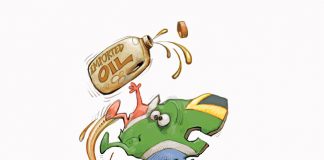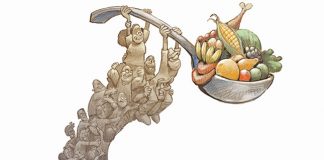
The world has to increase agricultural production to feed an increasing population on less land. This must be done without causing further detriment to the environment or impacting on the affordability of food. The volatility of global agricultural markets necessitates that agricultural decisions be evidence-based and not driven by ideology or emotions.
Eradicating hunger sustainably cannot be achieved without sound decision-making and it will require a significant increase in agricultural investment, specifically with regard to research and technology. The misconceptions about biotechnology need to be discussed and their importance in meeting national food security imperatives must be highlighted. We also need to focus on a regulatory framework which will contribute to the safe use of the technology.
Food security on the decline
According to a study released recently by the Human Sciences Research Council, national food security has declined from 48% to 45,6% since 2008. The study found that 26% of the population experience hunger, while 28,6% risk going hungry.
However, food insecurity and hunger in the country is not caused by a shortage of food but by the inaccessibility of food due to poverty and high food prices.
According to the National Development Plan, feeding the country demands a two-fold approach. Firstly, it requires efforts to increase food production and therefore food availability. Secondly, measures are needed to ensure that the poorest and most marginalised sectors of our society have the purchasing power to access the food that is available.
The capacity of national and global agricultural markets to absorb supply shocks and stabilise agricultural commodity prices is directly tied to the continued functioning of land and water systems. At the same time, climate change brings additional risks and further unpredictability of harvests. These include warming and related aridity, shifts in rainfall patterns and the frequency and duration of extreme events.
Non-agricultural developments on high and medium value agricultural land are also increasing. Mining, urban, infrastructure and residential development are major contributors to the reduced availability of land for agricultural production. A spatial statistical analysis undertaken in 2011 indicated that the surface area of land in South Africa suitable for crop production that had been irrevocably converted to non-agricultural uses through urban and mining developments, equals the size of the Kruger National Park. This area cannot be reclaimed to provide the food, feed and fibre necessary for the continued welfare of the population.
The relationship of population growth to the availability of high-value arable land for food production clearly indicates a declining trend, falling from 0,38ha per person per annum in 1996 to 0,31ha in 2005. It is estimated that the current figure for South Africa is less than 0,25ha, which is well below the international norm of 0,7ha.
GM vital – but only one tool
A carefully constructed combination of interventions and innovations is therefore required to ensure food security and the sustainable economic contribution by the agricultural sector. The Agricultural Sector Plan (2001) acknowledges the contribution that biotechnology can make to achieve a globally competitive, profitable and sustainable agricultural sector.
Caution, however, still needs to be exercised, as the use of GM technology in isolation cannot be regarded as the overall remedy to address all agricultural challenges. Instead, the technology must be viewed as just one of the many biotechnology tools available. Therefore it should be applied with caution and used in combination with existing conventional agricultural practices.
Safety concerns
While most biotechnology products appear to be adopted without much controversy, views about genetic modification or transgenics remain polarised. There are potential risks associated with genetic modification, and they should be addressed in a coherent, scientific manner. With the enormous number of food-insecure countries in Africa, we do not have the luxury of being influenced by emotional and unscientific propaganda. What is needed is sound decision-making based on scientific research, combined with comprehensive regulatory mechanisms.
In 2005, the World Health Organisation issued an opinion on the safety of food derived through biotechnology. It concluded that GM foods are not likely to present greater risk to human health than their conventional counterparts. It further stated that the risk assessment guidelines specified by the Codex Alimentarius Commission are adequate for the safety assessment of GM foods on the international market.
Developments in the EU of genetically modified organisms (GMOs) are often used as a yardstick for GMO safety. During 2010, eight EU member states grew GM crops. However, GM cultivation remains limited due to bans by individual member states, excessive monitoring requirements, and the limited choices farmers have, as there are only two approved GM varieties.
Commenting on the release of a 10-year collection of EU-funded GM research, the commission stated that there was no scientific evidence associating GMOs with higher risk to the environment or food or feed safety than conventional plants.
In 2003, South Africa became a contracting party to the Catagena Protocol on biosafety. Broadly stated, the protocol aims to ensure the safe transfer, handling, and use of GMOs and provides common procedures and rules when GMOs are involved in trans-border movement.
This further demonstrated our country’s commitment to the safe and responsible use of the technology. All the GMOs currently available in South Africa have been assessed according to these guidelines and are considered to be as safe as their conventional counterparts. It is widely acknowledged that environmental impact measurement is a complex undertaking, and subsequently environmental benefits from the application of GM technology are not easily quantifiable.
An industry-wide code of conduct, in the form of a biotechnology stewardship programme, is now being implemented. These stewardship programmes aim to ensure the responsible and ethical management of a biotechnology product, from its discovery or development to its ultimate use. The industry should continue to collaborate with regulators to ensure the safe and responsible use of the technology.
Massive economic value
Biotechnology plays an important role in agriculture as it offers the opportunity to increase production in a sustainable manner, thereby reducing poverty and food insecurity, while maintaining the natural resource base. In 2012, the area in South Africa under GM crops was estimated to be 2,9 million hectares. This represents a total of 86% of the maize crop, 90% of the soya crop and the entire cotton crop.
The overall economic impact of GM technology on farm income has been positive and could be ascribed to a combination of enhanced productivity and efficiency gains. It is estimated that since 1996, insect-resistant GM technology has added R250 billion to the income of global maize farmers. The adoption of the technology in the cotton sector since 1996 has contributed an additional R325 billion.
Between 1996 and 2011, South Africa’s farm income benefited by R9,32 billion from all GM crops available. GM traits have also contributed to a substantial reduction in the use of pesticides and herbicides. Since 1996, pesticides in GM crop areas have been cut by 8,9%, and researchers believe that this can be translated to an environmental impact reduction of close to 18%.
Email Wouter Wessels (ministerial spokesperson), at [email protected].
The views expressed in our weekly opinion piece do not necessarily reflect those of Farmer’s Weekly.













